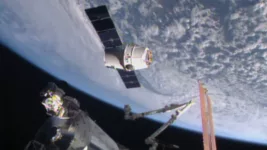SpaceX’s Dragon cargo ship has arrived at the International Space Station (ISS), carrying an experimental inflatable
space habitat that might be crucial for future deep space explorations.
The spacecraft was successfully captured at 7:23 a.m. Eastern Daylight Time (1123 GMT) by European astronaut Tim Peake,
using the orbiting lab’s robotic arm, with help from US astronaut Jeff Williams, Xinhua quoted the US space agency NASA as saying.
Another US commercial cargo ship called Cygnus has been attached to the station since 26 March. Two Russian Soyuz crew capsules
and two Progress cargo ships are also docked at the moment. As a result, “Dragon’ s arrival marks the first time two commercial
cargo vehicles have been docked simultaneously at the space station,” NASA said.
“With the arrival of Dragon, the space station ties the record for most vehicles on station at one time – six,” said NASA.
The last time six vehicles were docked to the station was back in the space shuttle era, when Discovery visited in February 2011.
Among the almost 7,000 pounds (3,200 kilograms) of items onboard Dragon is the 3,100-pound (1,400-kilogram) Bigelow Expandable Activity Module (BEAM), a $17.8 million project that will test the use of an inflatable space habitat in micro-gravity.
BEAM is expected to be filled with air to expand four-and-a-half times its original volume at the end of May after being attached to the ISS.
During its two-year test mission, astronauts will enter the module for a few hours several times a year to retrieve sensor data and assess conditions.
Science experiments onboard Dragon included those that will help investigators study muscle atrophy and bone loss in space, seek insight into the interactions of particle flows at the nano scale level and use protein crystal growth in micro-gravity to help design new drugs.
Dragon will remain connected to the ISS until 11 May, when it will depart for a parachute-assisted splashdown off the coast of California, bringing almost 3,500 pounds (1,600 kilograms) of science, hardware and spacewalking tools back to Earth for further study.








